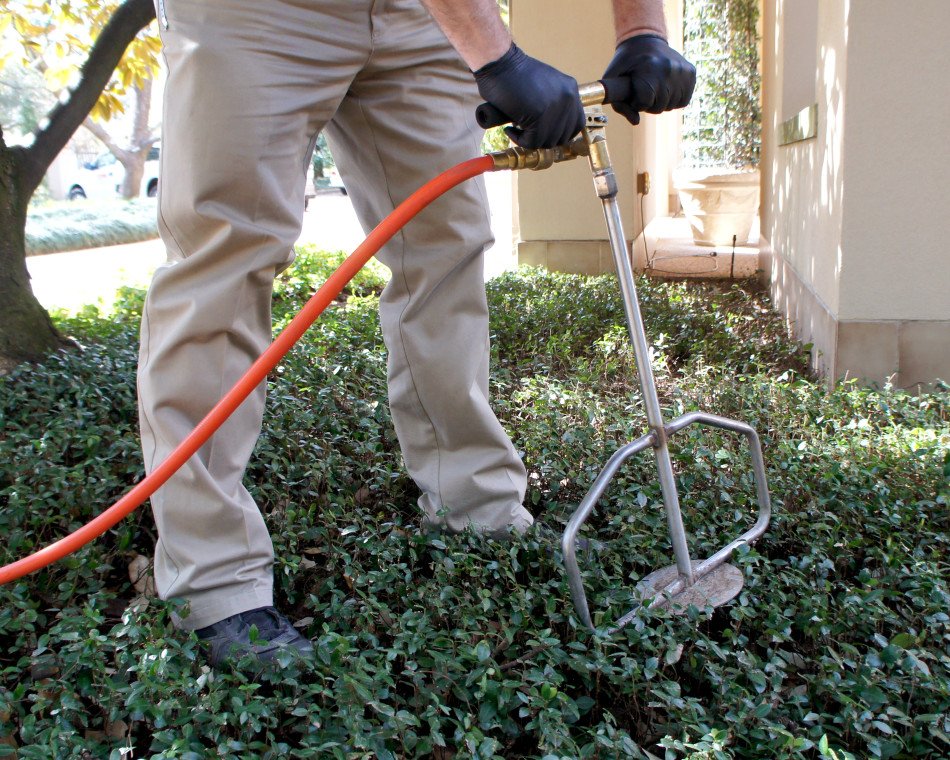PHC Solutions for Tree Restoration and Maintenance
Micro-Injection Treatments
 Microinjection is a technique that allows the direct introduction of materials, such as antibiotics,
fungicides, insecticides and mineral nutrients into a tree without spraying.
Microinjection is a technique that allows the direct introduction of materials, such as antibiotics,
fungicides, insecticides and mineral nutrients into a tree without spraying.
Microinjection is a type of trunk injection where small amounts of therapeutic chemicals, contained in sealed capsules, are injected into the trunk around the base of a tree. The injected chemicals are then distributed systemically
by sap movement within the tree to the branches, leaves and even roots, within a few hours after injection. Tree microinjection sets a new standard for economical and environmentally safe tree health care. Microinjection provides
a 21st century pest control alternative to foliar spraying. Spraying a tree canopy can be especially difficult in some conditions such as areas of high wind, very large trees or areas bordering water bodies. Microinjection
offers the ability to treat trees where spraying is not practical. By injecting either a pest control product or nutrients directly into the tree's vascular system, we can manage pest populations without spraying and fertilize
trees without depending on root function. Certain diseases and pests are most effectively and safely applied with this technique. We are well qualified and specifically trained to perform these technical treatments. We will
let you know when we think that this is the best solution for your trees.
Soil Sample Analysis
 Healthy trees and shrubs require a soil environment with adequate chemical, biological, and physical properties.
Productive soils contain the proper balance of necessary nutrients, biological organisms, and soil pore spaces. For example, soils deficient in an essential element such as Manganese may cause visual symptoms of stress
in trees including yellow, undersized leaves. Soil lacking an assortment of beneficial fungi, bacteria, and other micro-organisms is often compacted and lacks adequate structure and space for proper root growth and moisture
retention.In order to provide better care for our clients’ trees, we provide complete soil sample analysis.Soil analysis determines nutrient content, soil pH, nutrient exchange capacity, and organic matter content. We
provide this information by itself or as a first step towards developing prescription tree and shrub fertilization programs or soil management programs. Soil analysis includes professional sample collection and accurate
interpretation. Soil analysis reports are provided to our clients along with our recommendations.
Healthy trees and shrubs require a soil environment with adequate chemical, biological, and physical properties.
Productive soils contain the proper balance of necessary nutrients, biological organisms, and soil pore spaces. For example, soils deficient in an essential element such as Manganese may cause visual symptoms of stress
in trees including yellow, undersized leaves. Soil lacking an assortment of beneficial fungi, bacteria, and other micro-organisms is often compacted and lacks adequate structure and space for proper root growth and moisture
retention.In order to provide better care for our clients’ trees, we provide complete soil sample analysis.Soil analysis determines nutrient content, soil pH, nutrient exchange capacity, and organic matter content. We
provide this information by itself or as a first step towards developing prescription tree and shrub fertilization programs or soil management programs. Soil analysis includes professional sample collection and accurate
interpretation. Soil analysis reports are provided to our clients along with our recommendations.
Deep Root Feeding
 The single most important preventive measure you can take to enhance
the health, beauty, and vigor of your trees is to Deep Root Feed your tree’s root system. A successful Plant Health Care Program begins with the proper nutrients. Your J & Y Tree Arborist PHC Specialist can detect
impending problems and recommend the optimum time for fertilizing before signs of nutrient deficiency are visible and plant vigor has been compromised.
The single most important preventive measure you can take to enhance
the health, beauty, and vigor of your trees is to Deep Root Feed your tree’s root system. A successful Plant Health Care Program begins with the proper nutrients. Your J & Y Tree Arborist PHC Specialist can detect
impending problems and recommend the optimum time for fertilizing before signs of nutrient deficiency are visible and plant vigor has been compromised.
Why treat your roots?
Trees and shrubs in your landscape actually exist in a foreign environment, even “native species”, lacking the nutrients found in the rich layer of humus occurring naturally on the forest floor. In your landscape--where
there is limited natural fertilizer--tree roots must reach out to obtain the nutrients they need. Obstacles such as compacted soil, rock ledges, buildings, pools, and pavements often impede their ability to obtain nutrients.
Don't count on your lawn fertilizer to help. Only an insignificant amount--if any--will filter down to the tree roots.
When to treat?
You should treat your roots now, before the warning signs of nutrient deficiency are visible and the plant’s health has been compromised. J & Y Tree’s Arborists PHC Specialists can diagnose the situation and recommend
the optimum time to fertilize. Trees receiving regular applications of essential nutrients look better and live longer.One to three treatments per year are recommended depending upon the environment your trees live in. Spring
treatments are designed to stimulate seasonal growth and replenish soil nutrient levels. Summer treatments are designed to provide essential nutrients and water in the dry summer months. Fall treatments are designed to prepare
the tree for the stresses of winter, improve rooting and carbohydrate reserves.